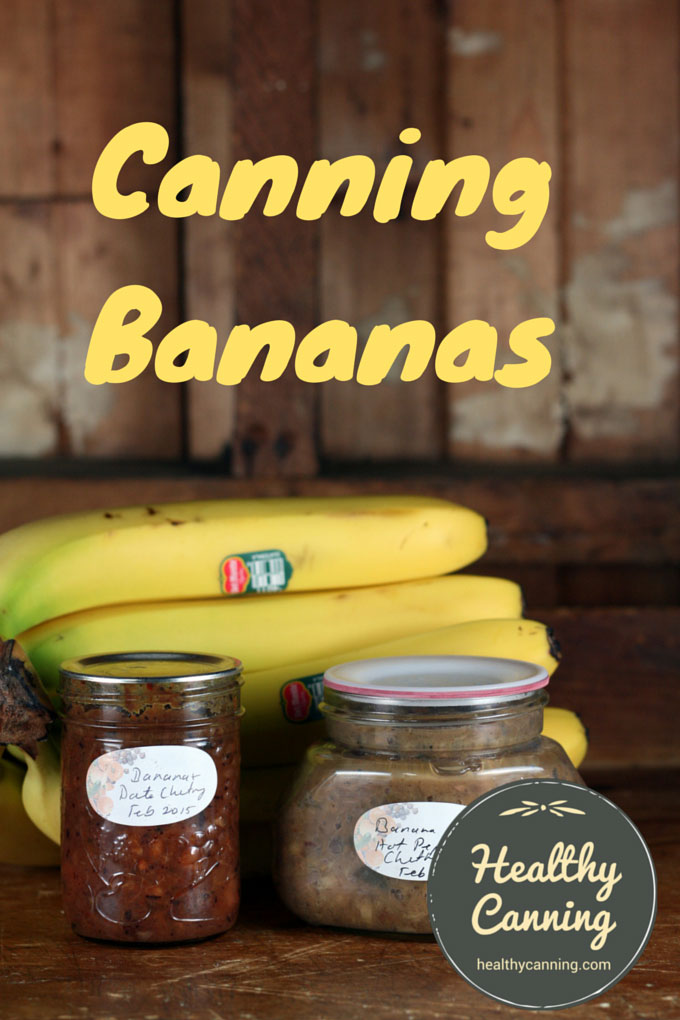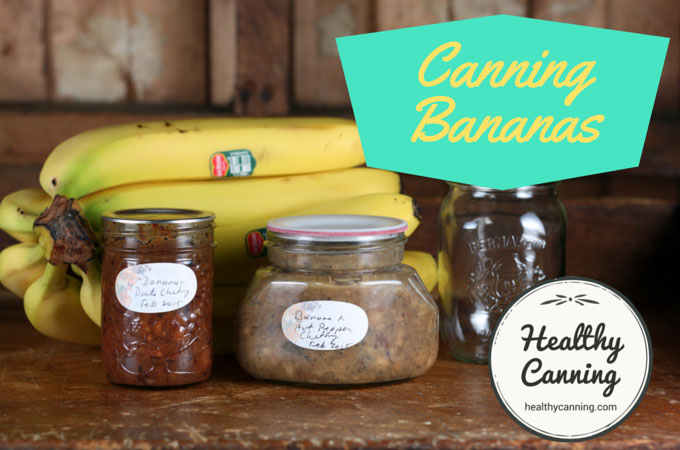We’ve all been faced with a glut of bananas, and longed for a way to deal with them other than banana bread. Can they be home canned?
The answer is: bananas can be used as an ingredient in home canning, but they can’t be canned plain on their own.
(And don’t forget: you can always dry banana slices into banana chips for snacking, or freeze overripe bananas for future use in baked goods.)
You can’t can plain banana on its own
Bananas are a dense, low-acid fruit, with a pH ranging from 4.5 up to 5.20 depending on the variety, growing conditions, etc. [1] FDA. Approximate pH of Foods and Food Products. April 2007. Accessed March 2015. (See: The role of pH in home canning.)
Owing to bananas being a low-acid fruit, plain banana on its own would have to be pressure-canned to make it safe from the intense heat treatment, but no testing by reputable sources has ever been done to determine how long this very dense fruit would require to kill all nasties in all cold spots of a jar. Consequently, there are no guaranteed safe ways to can banana plain.
Banana in preserves
You can use banana in tested preserve recipes which make the fruit safe by the addition of an acid which prevents botulism spores from germinating.
- Banana and Date Chutney (Canadian Living Test Kitchen) [2] Canadian Living Test Kitchen. The Complete Preserving Book. Montreal, Canada: Transcontinental Books. 2012. Page 224.
- Banana and Pepper Chutney (Linda Ziedrich, The Joy of Pickling. 2009) [3] Ziedrich, Linda. The Joy of Pickling. Boston: Harvard Common Press. 2009. Page 327.
- Banana Jam with Ginger, Raisins and Rum. (Linda Ziedrich. The Joy of Jams, Jellies, and other Sweet Preserves. 2009 Page 58.) [4]Ziedrich, Linda. The Joy of Jams, Jellies, and other Sweet Preserves. Boston, Massachusetts: The Harvard Common Press. 2009. Page 58.
- Fruity Banana Chutney (Ball / Bernardin Complete Book) [5] Kingry, Judi and Lauren Devine. Ball / Bernardin Complete Book of Home Preserving. Toronto: Robert Rose. 2015. Page 242.
- Orange-Banana Jam (Ball All New). [6]Butcher, Meredith L., Ed. The All New Ball Book of Canning and Preserving. New York: Oxmoor House. 2016. Page 36.
- Strawberry Banana Jam (Canadian Living Test Kitchen. Requires sugar.) [7] Canadian Living Test Kitchen. The Complete Preserving Book. Montreal, Canada: Transcontinental Books. 2012. Page 34.
- Strawberry-Banana Jam. (Developed by Pomona Pectin; sugar-free)
The three chutneys are as tasty as they are unique; they are all made safe by the addition of cider vinegar. The jams are made safe by the acidity of the other fruits and added lemon juice.
References



diane barnett
So if cooked bananas in with a little sugar and lemon juice to add to acidity, then put in hot jars and bathed it wouldn’t preserve them. Since you add sugar and lemon juice or ACV to them when making jelly.
Thomas
What about simple banana jam?
Healthy Canning
Hi Thomas,
We’re not yet aware of a lab-tested recipe from a reputable source for simple, plain banana jam. We update the banana page every time a new such tested recipe comes out, so there’s hope yet for the future.
Thomas
Hello Randal and thanks for your answer.
I bought a jar of banana jam a few years ago, from a store. I still remember buying it to this day, because I never see banana jam anywhere and I always wondered why. I had no idea it wasn’t safe!
Healthy Canning
Commercially preserved products are a whole different ball game from home canned, because they have access to equipment that consumers don’t. They also spend the $$$ (often a lot) to specifically test a specific recipe, and then put controls into place with no allowance for error to make sure that recipe is always followed to the letter. So, your commercial plain banana jam was presumably safe, if it was allowed to be sold. You may find this post interesting from the National Center for Home Food Preservation.
https://preservingfoodathome.com/2013/04/16/why-cant-i-can-what-companies-can/
Thomas
Interesting, thanks for the explanation and linked article!
A Winter
Distinction should be made between home canning and commercial. There are no tested recipes from reputable sources for canning bananas at home. This does NOT mean that commercial products are unsafe. For example, pumpkin purée is considered unsafe to can at home, but it is commercially common and reliable.
Diane
How about: https://www.kraftrecipes.com/recipes/surejell-banana-butter-57356.aspx
Healthy Canning
Hi Diane, I notice that they don’t have you sterilize the jars. For processing over 10 minutes, sterilization is no longer recommended, as the processing handles it, but it’s still required for processing under 10 minutes. Did you catch that — only 5 minute processing but no sterilizing of the jars?
Heidi Lynn M.
Is Their anyone to whom we could email a recipe to, so it could be checked to see if it is “Safe”
Healthy Canning
Not really. Actually testing of a recipe in a certified lab is a very involved process.
That being said, you could try bringing your recipe to the forum people over at https://forums.gardenweb.com/forums/harvest. There are many safe canners in that forum.
Hope that helps.